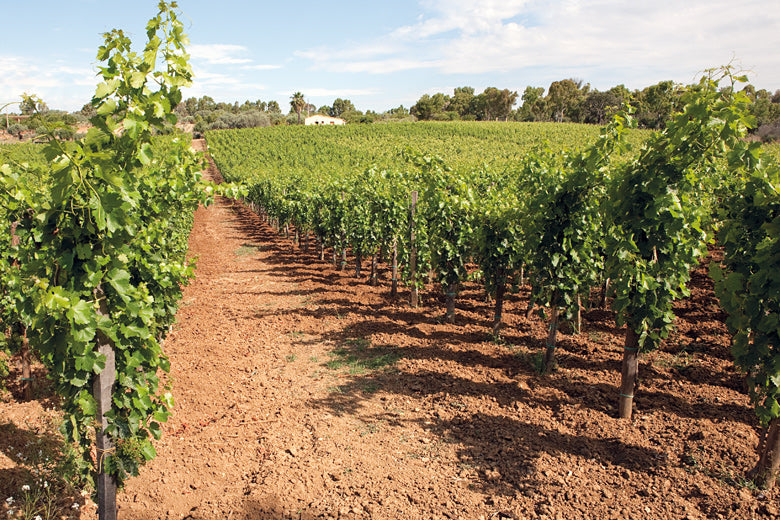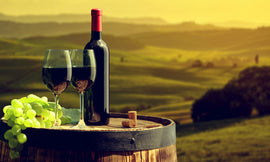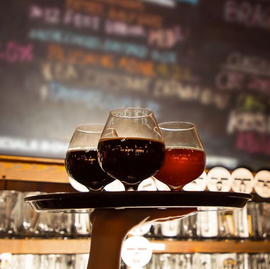Happy New Year! We start the year with two selections from islands I have never, until now, been very familiar with. Both Santorini and Sicily have long histories of grape cultivation, but many of their wines have for centuries been limited to local consumption. How fortunate are we, that in modern times, wines from such distant lands can be enjoyed in our own homes? Get out your organoleptic passport, grab a corkscrew and a glass, and get ready for a delicious journey. We will be taking many more trips throughout the year. Our producers this month have created wines in which Old and New World wine characteristics and philosophies coincide and cohabitate. Their wines showcase their distinct senses of individuality, authenticity and place. And most important, from a drinking point of view, they are delicious!
2016 Argyros Assyrtiko DOP
Santorini, Greece
Modern-day Greece is situated on a large peninsula at the confluence of the Mediterranean, Ionian and Aegean Seas. It has more than 200 populated islands, and archaeological evidence suggests that winemaking has existed on many of them for at least 4000 years. The main wine growing regions of Greece include: the Aegean Islands (Crete, Limnos, Paros, Rhodes, Samos, Santorini), Central Greece (Attic, Epirus, Zitsa, Thessaly, Rapsani, Ankhialos, Ionian Islands, Kefalonia), Macedonia (Amyntaion, Goumenissa, Naoussa), and Peloponnesus (Mantinia, Nemea, Patras).
Santorini, whose official name is Thira, is the southernmost island of the Cycladic cluster in the southern Aegean. For over 35 centuries, the geomorphology and fortunes of the island have been stamped by its volcano’s eruption. Geologically, the island is all that remains of an ancient volcanic cone, whose eruption created the cliffs and lagoon around which the Santorini tourist trade thrives. The first signs of winemaking in Santorini go all the way back to 3500 BC, but it was the catastrophic volcanic explosion near 1600BC that created the island’s unique terroir and has given the wines of Santorini their unique character. The explosion left behind a mixture of volcanic ash, pumice stone and pieces of solidified lava and sand, which together make up the soil of Santorini, known as “aspa”. The soil has little to no organic matter, but is rich in essential minerals, except potassium, creating wines with a naturally low pH level and high acidity. Today, vineyards are seen all over Santorini, especially on the island’s central and northern parts. A small part of the vineyards is also located on nearby Thirassia Island, which is included in the PDO (protected designation of origin) Santorini wine zone (est.1971). Vineyards and wine form an important, traditional part of culture on the island, but is increasingly threatened by the island's ever-expanding tourism industry. Because of the tough growing environment and the demanding viticultural practices required to maintain the vines, it has become a difficult economic choice for the producers to continue making wine. The average vineyard in Santorini is less than 1 hectare in size and is family-owned, making it very challenging for the growers to depend solely on the vine for their income. The profitability of hotels, restaurants and nightclubs has forced land prices up significantly in recent decades, making winegrowing a less-attractive commercial prospect.
The PDO Santorini vineyards are planted with original rootstock, since the pest of phylloxera cannot survive on the island’s volcanic soil. The vines’ trunks are pruned in a wreath-like basket shape (“kouloures” or “ambelies”) within which the grapes, sheltered from the sun and the northerly winds, grow with virtually no water. As with the rest of the Cycladic Islands, Santorini has many indigenous grapes, but the most important one is Assyrtiko.
Founded in 1903, the Argyros Estate is located on the island of Santorini. In 1950, the Argyros vineyards were passed down to the founder’s son, who tripled the estate from 5 to 15 acres. Yiannis Argyros, the third-generation owner of the estate who took over in 1974, began looking beyond the local market for his wines. Today, Mathew Argyros, the fourth generation of family winemakers, continues his father's legacy by making remarkable wines from Assyrtiko and other indigenous Santorinian varietals using traditional techniques. The estate vineyards are located primarily in Episkopi and Pyrgos, which are prime locations for Assyrtiko. The ungrafted vines range in age from 30 to over 150 years and are trained into the traditional "kouloura". Argyros practices sustainable viticulture, using composted grape must as fertilizer, and plowing the vineyards with mules. Indigenous to Santorini, Assyrtiko makes a powerful, deeply mineral, long-lived white wine that has few rivals when in the hands of a top-flight producer like Estate Argyros. The grapes used for Estate Argyros Assyrtiko are harvested from the oldest parcels of the estate. Located in Episkopi, the average age of the vines is 150+ years old, with some vines over 3 centuries old, resulting in extremely low yields. After a thorough selection, the grapes undergo a brief gentle pneumatic pressing. After fermentation (90% in stainless-steel, 10% in barrel), 20% of the wine is aged in 2nd and 3rd use 500L French oak barrels for 6 months, with periodic battonage. The wine is then bottled and aged 6 months before release. The 2016 Estate Argyros Assyrtiko reveals apple blossom, lime zest, and a touch of salinity in the nose. In the mouth, the wine is intense with fresh acidity, and flavors of citrus fruit and minerals coat the palate and linger in the finish. While excellent on its own as an aperitif, Estate Argyros Assyrtiko is an excellent wine to pair with food. Try it with fresh oysters, all types of seafood dishes, smoked cheeses, and roasted pork loin.
The 2016 Estate Argyros Assyrtiko is $25.00/bottle, $270.00/case.
2013 Azienda Agricola Daino Gianfranco “SUBER”
Sicily, Italy
Sicily is the largest island in the Mediterranean Sea. The island is divided into nine provinces that include more than 1,000 miles of coastline, natural reserves, the largest volcano in Europe, and endless cultivated hills and plains.
For more than 2,500 years, Sicily has been a significant center of viticulture in the Mediterranean. Geographically, the island can be divided into four macro areas: east, central, west and, finally, the islands of Pantelleria and Favignana. It is a diverse mosaic of microclimates and soil types that has resulted in 23 DOCs (Denominazioni di Origine Controllata) and one DOCG (Denominazione di Origine Controllata e Garantita). Some of these DOCs are little known, even within Sicily, and account for only 5% of the island’s overall production. The DOC(G)s that are best-known are Etna, Marsala, Pantelleria and Cerasuolo di Vittoria. One of the many remarkable things about Sicily is that its harvest lasts for over three months, beginning in the August heat of Trapani and ending on the snow-peaked slopes of Etna in mid-November.
Gianfranco Daino's winery lies within the Bosco di Santo Pietro woods, 20 km from the city of Caltagirone, a municipality in southeastern Sicily near the northern limit of the Cerasuolo di Vittoria DOCG. For centuries farmers have worked the lands of Caltagirone, passing down their skills to the present day in the cultivation of Nero d'Avola, Frappato, and Alicante (Grenache). Daino’s estate, spreading over 6.5 hectares of natural beauty, is situated at 325 meters above sea level. Daino was looking to create a wine with a pure and distinct character from their estate which is set in an old cork forest and nature preserve with red sandy soils and Mediterranean arenaceous rock, which differs from the wines of Etna (all volcanic) and Vittoria to the south which is more limestone/seabed-based. The vineyards are planted with a density of 9,000 vines per hectare and are farmed organically using traditional techniques. Etna enologist Salvo Foti helped Daino plant his albarello (little tree) vines and adopt ancient bush-training methods (“To give each plant the right amount of soil and sun,” says Foti). A native of the city of Catania, Salvo studied enology and began his career in 1981 as a technical and agrarian advisor to some noted estates in eastern Sicily. “I Vigneri” takes its name from an association that existed in the Etna region in 1435, Maestranzi dei Vigneri, an association of vineyard workers that greatly influenced the wine culture of the Etna region. Today, “I Vigneri” is an association between Salvo Foti, other vine experts and local grape growers who bring their long experience among the particular vines of Sicily to their work in the vineyard and cellar. “I Vigneri,” the name of Foti’s vintners’ association, is emblazoned on all Daino’s bottles.
Daino’s only wine is called SUBER, named after the majestic Quercus Suber (cork oak) trees which populate the Bosco Santo Pietro woods. The wine is a blend of 50% Nero d’Avola, 30% Alicante (Grenache), and 20% Nero Capitano (Frappato). Once harvested, the grapes for SUBER are fermented in stainless steel using the latest technology, and then aged in small barrels for 12 months, and 6 months in bottle. The Nero d'Avola contributes an aroma of red fruits, such as blackberries or mulberries; the Frappato adds an aftertaste of stone fruits; the Alicante gives Suber alcoholic strength and enriches it with a hint of fragrant spices. The nose of the 2013 SUBER has a mix of floral and spicy tones with a hint of black fig leading to a warm palate of blackberry, plum, raspberry and dark liqueur. The wine continues to open with flavors of dusty raisin, anise, a mix of spice, earth, and mineral. There is some grip and the finish is long with a nice play between sweet and savory elements. This is an interesting and intriguing wine, best to enjoy in its youth, but will continue to develop over the next few years. Try the 2013 SUBER with Farsumagru- steak stuffed with meats, cheese, eggs and vegetables and then rolled to look like a roast, Braciole alla Sicilian-veal cutlets filled with olives and capers and grilled over coals, and Involtini di Carne-meat roll-ups stuffed with ham, cheese and pistachios.
The 2013 Daino SUBER is $27.00/bottle, $291.60/case.
Cover Image via Daino Estate





